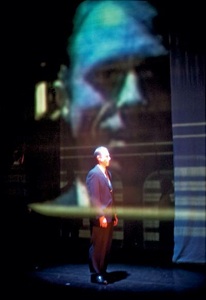In 2009, Caryl Churchill wrote a short play to raise awareness of the Israeli Defence Force's attack on Gaza (Operation Cast Lead) and to raise money for the British charity Medical Aid for Palestinians. The piece takes the form of a series of seven short scenes, taking snapshots of seven moments in the contemporary experience of the Jews and of the state of Israel; in each scene adults discuss how to explain to a young girl what is happening. Most of the dialogue takes the form 'Tell her...' This deferred and mediated structure is somewhat riddling and complex, the events being refracted through the child and the parents and relatives' various attitudes. However, almost immediately, Churchill was accused in some quarters of having written an anti-semitic play and even of having revived the medieval Blood Libel.
I gave a paper - Theatrical Images & the Theatrical Imagination: the scandal of Seven Jewish Children - at the Sorbonne's VALE (Voix Anglophones: Literature et Esthétique) research group. My basic claim is that the play is itself trying to speak about what it is possible and not possible to speak about. I suggested - rather clumsily - that the play is trying to hold open a space for complexity and ambiguity. By ambiguity, I don't mean it is trying to be even-handed or to sit on the fence: it is fairly clearly trying to understand why the Israeli Jews, having been on the receiving end of such suffering, are now able to mete out fairly brutal suffering on the Palestinians. (And let me say quickly, nothing in the play tries to suggest that there is any sort of equivalence between the Holocaust and the Israeli treatment of the Palestinians, which would be a crass thought.) What the affair reveals, I think, is that those who wish to close down cultural debate often resort to a kind of literalism about culture that closes down the imaginative spaces that art is particularly adept at opening. Art's ability to be metaphorical, ambiguous, to offer what Kant calls 'aesthetic ideas', that is, representations, references, concepts corresponding to the world but which have a kind of movement in them, a shimmer that allows them to slip their moorings and function in different ways, making lateral associations and new connections.
The talk provoked some interesting debate. Some doubted that the play is significantly ambiguous at all and that in fact it offers a fairly clear, polemical line against Israel (though no one in the room took seriously the suggestion that it is anti-semitic). It was suggested that the play's meanings are limited not by the rhetorical devices of its detractors but by our shared knowledge of Israel's history. When one of the parents says 'Don't tell they're Bedouin', I suggested the line could be understood as both a sincere and an insincere statement - and certainly could be played either way. The counter-argument is that there are historical facts to be considered: the indigenous Palestinian Arabs weren't Bedouin and that must arrest the ambiguous movement of the play.
As I was working on the paper, I found the play more and more elusive, which slightly hamstrung the presentation, but it was interesting to give some very provisional thoughts an airing and to have to defend them from some enjoyably robust questioning.



![photo[1].jpg](https://images.squarespace-cdn.com/content/v1/513c543ce4b0abff73bc0a82/1362919072201-PZO854G4SEB794DVOEI8/photo%5B1%5D.jpg)
